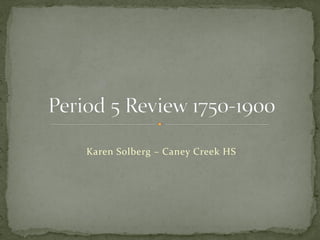
2017 APWH Period 5 Review
- 1. Karen Solberg – Caney Creek HS
- 2. Industrial Revolution begins in Britain & spreads to north & west Europe Agricultural improvements Water, coal, timber, canals, rivers, MONEY Steam engine Internal combustion engine (fossil fuels) Amount of energy available skyrockets Second Industrial Revolution Steel, chemicals, electricity Precision tools Germany is a leader in this
- 5. The Factory System=concentration of labor Rigid schedule; 6 days/wk 12-14 hour day; one break Dangerous conditions. Mind-numbing monotony.
- 6. New transportation & communication emerge Railroads Steamships Telegraphs Canals Similar industrialization spreads to the USA Government reforms expand suffrage (voting) in Britain without revolution, public education becomes widespread State-sponsored industrialization happens in Tsarist Russia and Meiji Japan
- 9. Latin American export economies Export meat, wheat, guano, rubber Import European & N. Amer finished products Decline in Asian & MidEastern manufacturing Ex. Less textile production in Egypt & India Some trade is “created” to give European/US companies a trade advantage Opium produced in India is sent to China Palm Oil is produced by forced labor in Africa & sent to Europe Cotton plantations in southern U.S. send cotton to Europe
- 11. New metals such as copper are needed for machines Discovery of diamonds & increased demand for gold & silver lead to new mining centers TNCs (trans-national corporations) emerge in response to global trade United Fruit Company (US business in C. America) Britain’s Hong Kong & Shanghai Banking Corp.
- 13. Economic changes occur Capitalism – Adam Smith Liberalism – John Stuart Mill Stock markets emerge LLCs Insurance companies
- 14. Trade unions Utopian socialism Marxism Anarchy
- 16. Resistance to economic change in Qing China and the Ottoman Empire. Some in these empires wanted to see reforms in imperial policies Tanzimat Movement in Ottoman Empire Self-Strengthening Movement in Qing Both failed more or less Some empires led a full-fledged, state-sponsored industrialization movement Meiji Restoration Muhammad Ali’s textile industry in Egypt Trans-Siberian railroad in Russia
- 18. Middle class ideology develops in Western Europe Victorian Age Gender roles change Women went from cottage industry to factories to married life or white-collar jobs (or were domestics) Rapid urbanization = unsanitary living conditions Public education increases as suffrage increases Demand for women’s suffrage challenged these traditional roles Mary Wollstonecraft’s A Vindication of the Rights of Woman Olympe de Gouges’s “Declaration of the Rights of Women and the Female Citizen”
- 19. Political Imperialism! British control in India increased over the period British & German colonies increased in Africa & Asia Japan in the Pacfic Spanish & Portuguese colonies declined Settler colonies emerged in Australia, South Africa & New Zealand (Britain); Algeria (France) Economic Imperialism Britain & France “open” China after the Opium Wars Britain & Germany invest heavily in Argentina & Brazil German nationalism disrupts balance of power in Europe Britain & Germany become rivals for power
- 21. “Science” was used to justify racial subjugation during the era of imperialism Anti-imperial resistance to racism and discrimination took place in colonies
- 22. Declaration of Independence, Declaration of the Rights of Man and Citizen, and Bolivar’s Jamaica Letter are inspired by Enlightenment thinkers Voltaire Rousseau Locke Becomes a challenge to established political structure and social conditions Absolute monarchy Slavery & Serfdom Gender equality
- 24. Nationalism is a sense of commonality based on language, religion, social customs & territory Unites Germans to form Germany (and Italians in Italy)
- 25. Land Empires weaken Taiping Rebellion against Qing weakness North American Revolution, Haitian Revolution and Latin American Revolutions French Revolution challenges absolute monarchy and the Old Regime Slave Rebellions & Maroon Colonies Anti-foreign resistance Sepoy Rebellion in India Boxer Rebellion in China
- 27. Demographic changes in industrialized and non- industrialized societies led to mass migrations: Relocation to cities worldwide Cheap transportation Ex. Italians work in Argentina; North Africans to mines Many chose freely to relocate for work Irish & Polish to USA Slavery is abolished, but coerced or semi-coerced labor results in migrations of Indians and Chinese to former slave territories Convict labor (Australia)
- 28. Absence of males leaves women to take on traditionally male roles in Africa and SE Asia Ethnic enclaves are created to support and transplant migrants “Chinatowns” in San Francisco “Little Italy” in Chicago Indian enclaves in South Africa Ethnic and racial prejudice attempted to regulate the flow of migrants Chinese Exclusion Acts of 1882 White Australia Policy of 1901
- 31. Europe creates new military technology & tactics that increases the number of wartime casualties Tanks Airplanes Trench warfare Blitzkreig Tsarist Russia collapses to Bolshevik communism Lenin had created an alternative to the existing order Britain negotiates Indian independence Algeria and Vietnam have to fight France for independence
- 36. Former colonial subjects move to imperial metropoles but retain their ethnic identities Nigerians & Indians in British cities Algerians in French cities WWII is spurred by the global depression of the ‘30s Governments take an active role in national economies The Holocaust was an example of ethnic violence World Wars are the first total wars Fascism, Nationalism, Communism mobilize all resources for war Propaganda Britain displaces Palestinians when the Balfour Declaration leads to the creation of Israel
- 39. League of Nations & UN attempt to increase international cooperation Cold War military alliances NATO Warsaw Pact Stalin’s 5 Year Plans put industrialization completely in the hands of the communist party of the USSR United Nations promotes a New World Order after the Cold War Britain under Margaret Thatcher encourages capitalism to thwart communism EU promotes economic unity in Europe
